Complete Solutions to Examples of chapter RAY OPTICS of Class 12 book with complete answers and questions
| Class 12 | PHYSICS |
| Chapter | RAY OPTICS |
| DC PANDEY NEET | Examples |
| Number Of Questions | 95 |
| Academic Year | 2023-24 |
A ray of light is incident at an angle of `30^(@)` with the plane of a plane mirror. Find the angle of reflection.
View SolutionA point objects O is nat angle of `30^(@)` from the plane mirror M, as shown In the figure. If OO'=2m, then find the location of the image

View SolutionConsider a ray of light is incident on aplane mirror M. If deviation produced by the mirror in the incident light ray is `120^(@)` then, find I and r.

View SolutionTwo plane mirror `M_(1)` and `M_(2)` area inclined at angle `theta` as`
` shown. A ray of light 1, which is parallel to `M_(1)`strikes `M_(2)` and after two
reflection , the ray 2 become parrallel to `M_(2)`.Find the angle `theta`
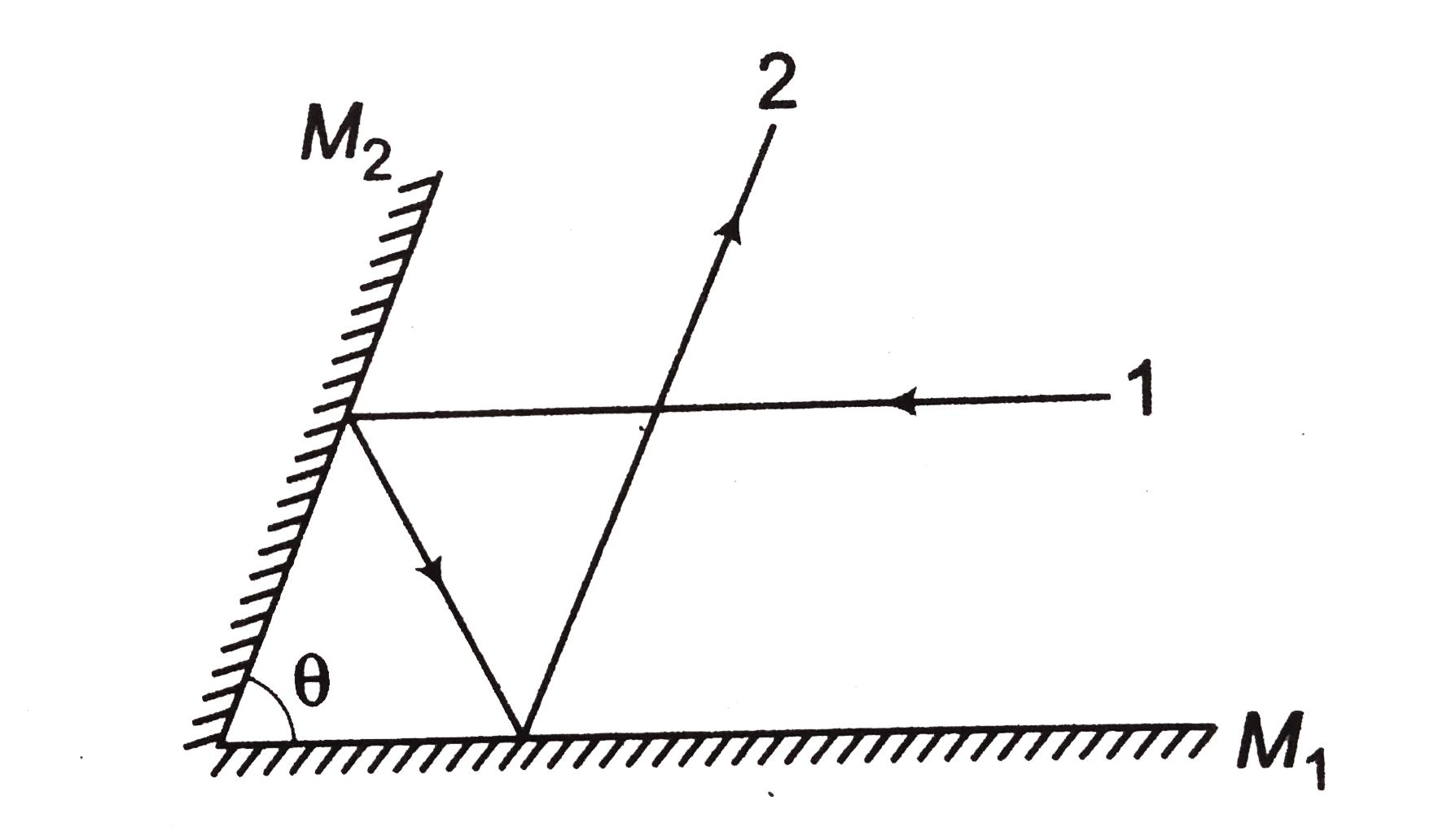
View Solutiona ray of light is incident on a plane miror at an angle of `30^(@)` in anti-clockwise direction. Find the angle and sense of rotation of the reflected ray.

View SolutionA point source of light S, placed at a
distance L in front of the centre of a mirror of width d,
hangs vertically on a wall. A man walks in front of the
mirror along a line parallel to th mirror at a distane
2L form it as shown.The greatest distance over which
he can see the image of the light source in the mirror is
(a) `d//2` (b) d (c) 2d (d) 3 d.
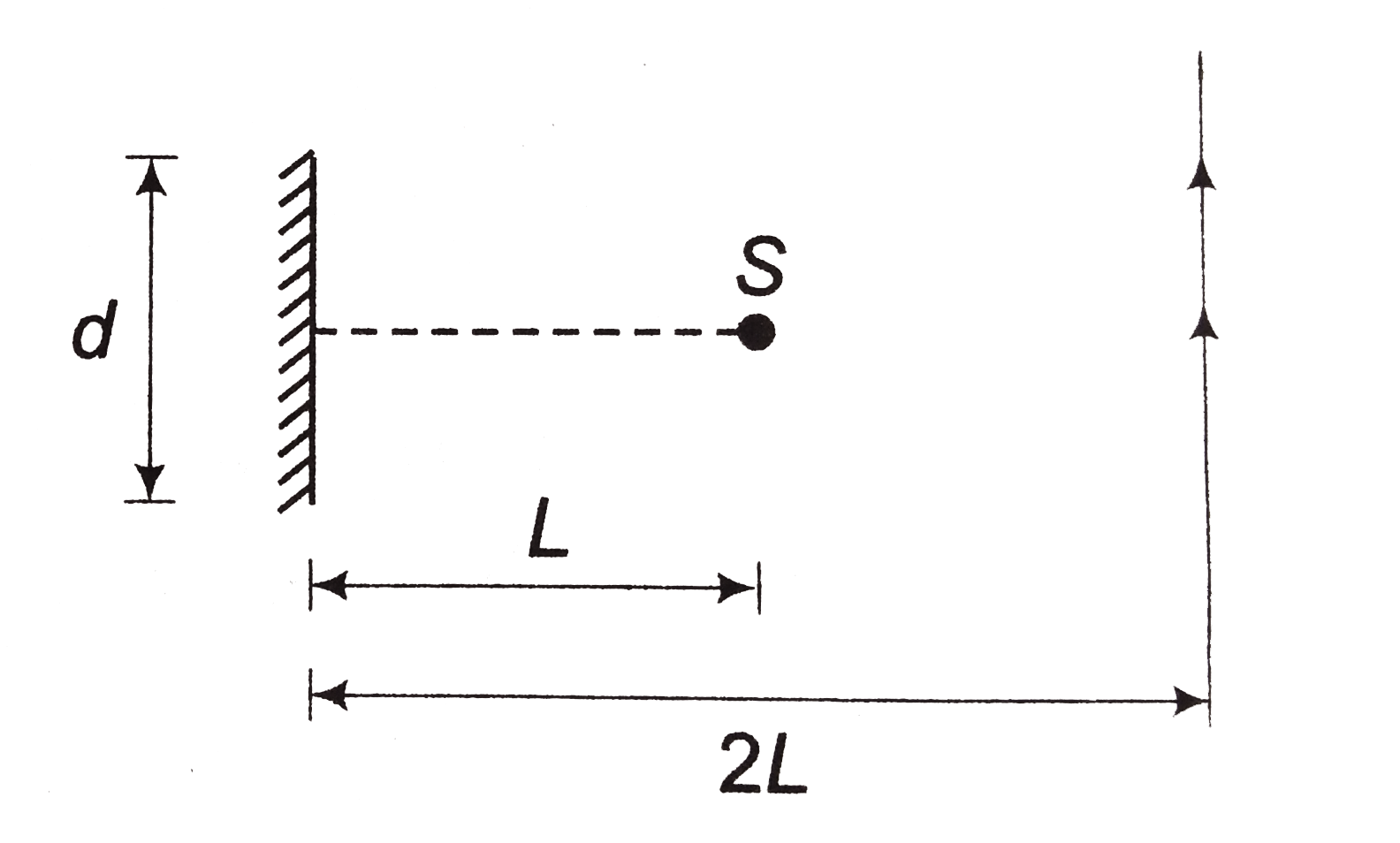
View SolutionConsider a point object moving towards a stationary plane mirror with velocity 5m`//`s. Find velocity of image w.r.t

View SolutionConsider two plane mirrors inclined at an angle `theta` as shown in figure. Find the number of object O formed these mirror when

(i)`theta=60^(@)`
(ii) `theta=72^(@)` and the object at `40^(@)` from `M_(1)`
(iii) `theta=72^(@)` and the object is at `36^(@)` from `M_(1)`
(iv) `theta=80^(@)`
View SolutionTwo plane mirror are placed paralled to each other at a seperation of 6m as shown in figure. Find the (i) number of images of the object O, (ii) seperation between 5th image.

View SolutionAn object is 30.0 cm from a spherical mirror along the central axis. The absolute value of lateral magnification is `(1)/(2)`. The image produced is inverted. What is the focal length of the mirror?
View SolutionA 4.5 cm needle is placed 12 cm away from a convex mirror of focal length 15 cm. Give the location of the image and the magnification. Describe what happens as the needle is moved farther from the mirror?
View SolutionA small candle `2.5 cm` in size is placed `27 cm` in front of a concave mirror of radius of curvature `36 cm`. At what distance from the mirror should a screen be placed in order to receive a sharp image ? Describe the nature and size of the image. If the candle is moved closer to the mirror, how would the screen have to be moved ?
View SolutionDetermine the diameter of the image formed by a spherical concave mirror of focal length 8 m. The diameter of the moon is 3450 km and the distance between the earth and the moon is approx `4xx10^(5)` km.
View SolutionFind the distance of object from a concave mirror of focal length 10 cm so that image size is four time the size of the object.
View SolutionA concave mirror has a radius of curvature of 24 cm. How far is an object from the mirror, if an image is formed that is
(i) virtual and 3.0 times the size of the object,
(ii) real and 3.0 times the size of the object and
(iii) real and `1//3` the size of the object?
View SolutionA thin stick of length f/5 placed along the principal axis of a concave mirror of focal length f such that its image is real and elongated just touch the stick. What is the magnification?
View SolutionA convex mirror is formed from a spherical surface of radius 20 cm. Find the power of the mirror.
View SolutionAn object is 40 cm form a spherical mirror, along the central axis. The image produced is inverted. What is the power of the mirror?
View Solution(i) Find the speed of light of wavelength `lambda`=780 nm (in air) in a medium of of refractive index µ=1.55.
(ii) What is the wave length of this light in the given medium?
View SolutionLight of wavelength 300 nm in medium A enters into medium B througha plane surface. If frequency of light is `5xx10^(14)` Hz and `v_(a)//v_(b)=4//5`, then find absolute refractive indices of media A and B.
View SolutionA ray of light falls on a glass plate of refractive index `mu=1.5`.
What is the angle of incidence of the ray if the angle between the reflected and
refracted rays is `90^@`?
View SolutionRefractive index of glass with respect to water is `(9//8)`.
Refractive index of glass with respect to air is `(3//2)`. find the refractive index of water with respect to air .
View SolutionFig. (a) and (b) show refraction of an incident ray in air at `60^@` with the normal to a glass-air and water-air interface respectively. Predict the angle of refraction of an incident ray in water at `45^@` with the normal to a water glass interface. Take `.^a mu_g = 1.32`.
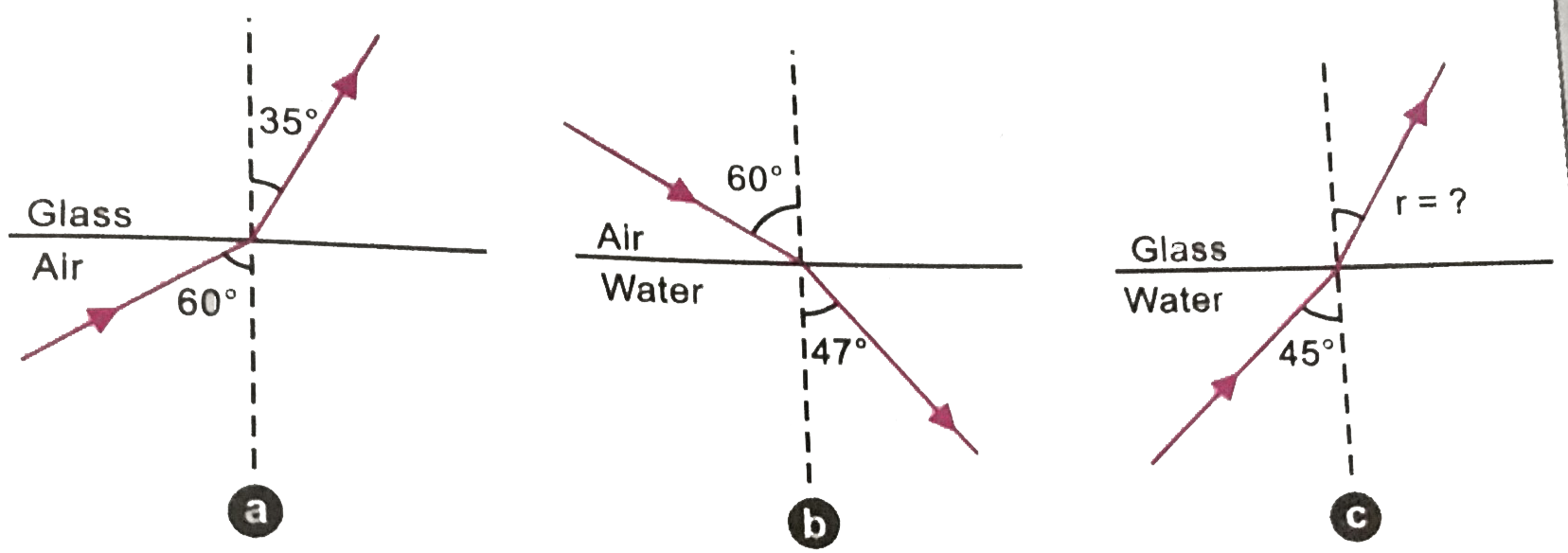 .
.
View SolutionA light beam passes from medium 1 to medium 2. Show that the emerging beam is parallel to the incident beam.
View SolutionA rectangular glass block of thickness 10 cm and refractive index 1.5 placed over a small coin. A beaker is filled with water of refractive index `4//3` to a height of 10 cm and is placed over the glass block.
(a) Find the apparent position of the object when it is viewed at near normal incidence.
(b) if the eye is slowly moves away from the normal at a certain position, the object is found to disappear, due to total internal reflection. At what surface does this happen and why ?
View SolutionA pile 4m high driven into the bottom of a lake is 1m above the `
`water . Determine the length of the shadow of the pile on the bottom of the lake if `
` the sun rays make an angle of `45^@` with the water surface . The refractive index`
` if water is `4/3`. `
View SolutionA printed page is kept pressed by a glass cube (µ=1.5) of edge 9.0 cm. By what amount will the printed letters appear to be shifted when viewed from the top?
View SolutionConsider the situation as shown in the diagram.
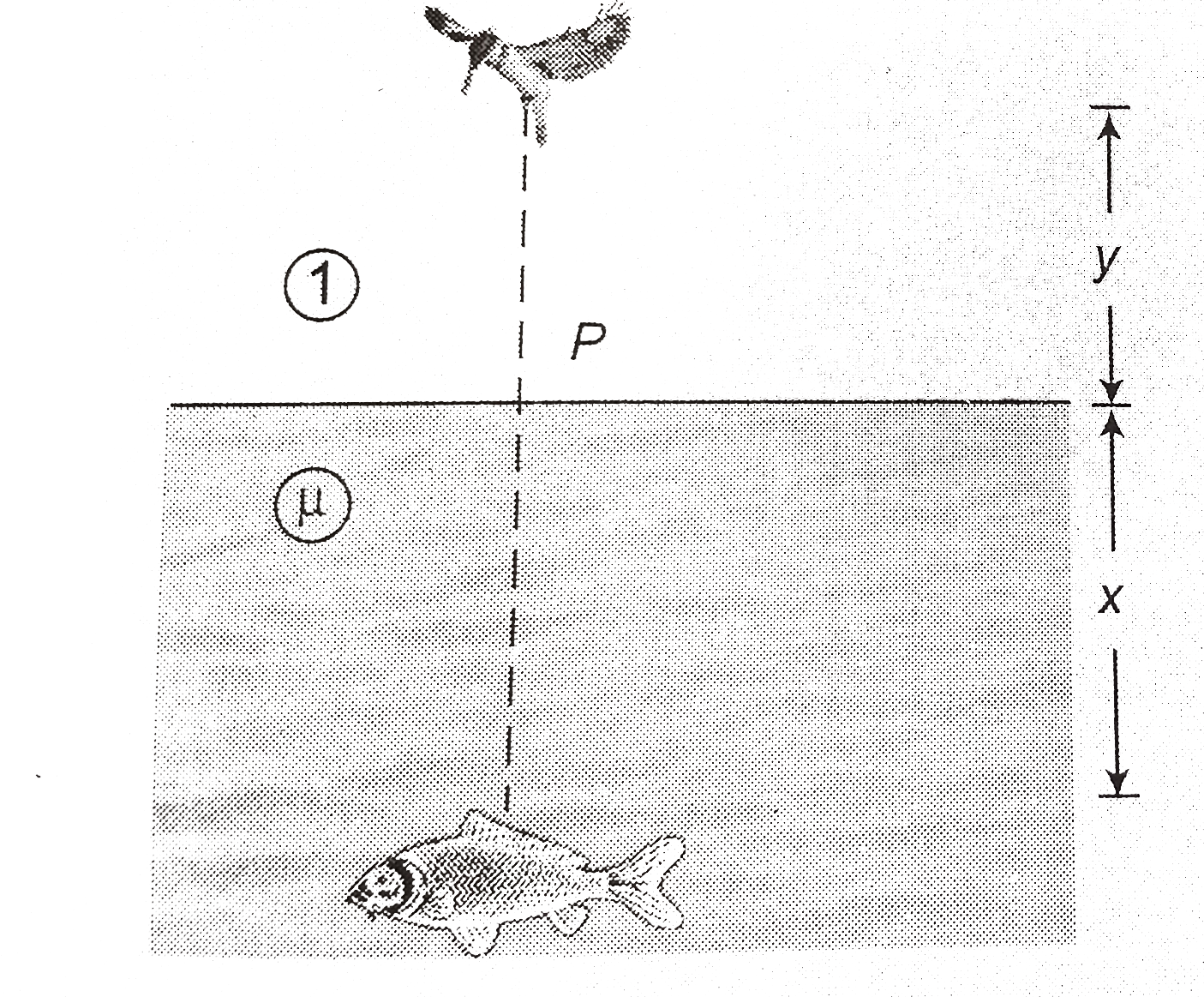
Find the distance between bird and fish as seen by (a) bird and (b) fish
View SolutionA fish in an aquarium approaches the left wall at a rate of `3ms^(-1)` observes a fly approaching it at `8ms^(-1)`. If the refractive index of water is `(4//3)`, find the actual velocity of the fly.
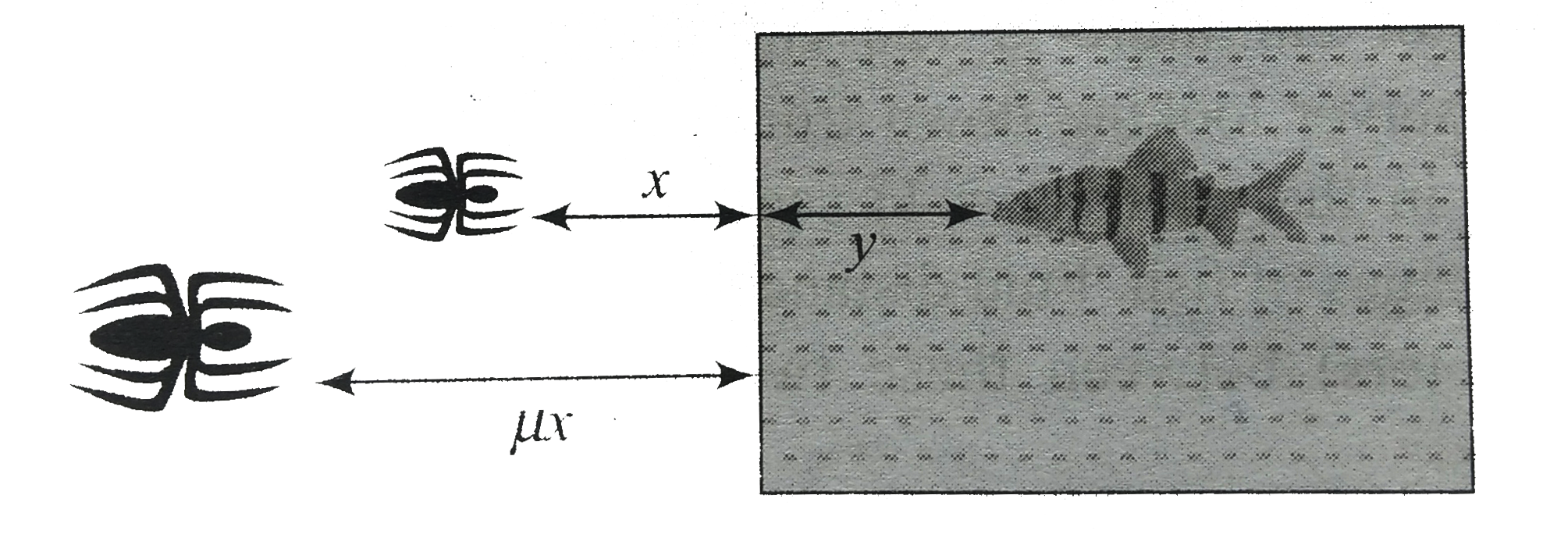
View SolutionA concave mirror of radius of curvature two meter is placed at the bottom of the tank of water. The mirror forms an image of the sun when it is directly overhead. Calculate the images from the mirror for (i) 160 cm and (ii) 80 cm of water in the tank. (Take,µ=4/3 for water)
View Solution
Consider the situtaion shown in figure. Find distance of image of O from eye E.
View SolutionA small pin fixed on a table top is viewed from above from a distance of `50 cm`. By what distance would the pin appear to be raised, if it be viewed from the same point through a `15 cm`. Thick glass slab held parallel to the table ? `mu` of glass `1.5` Does the answer depend on location of the slab ?
View SolutionA light ray is incident at an angle of `45^(@)` with the normal to a 4 cm thick plate (u = 2.0). Find the shift in the path of the light as it emerges out from the plate.
View SolutionA point object O is placed in front of a concave mirror of focal
length `10 cm`. A glass slab of refractive index `mu=3/2` and thickness `6cm` is
inserted between object and mirror. Find the position of final image when the
distance x shown in figure is

(a) `5cm` , (b) `20cm`
View SolutionAn isotropic point source is placed at a depth h below the water surface. A floating opaque disc is placed on the surface of water so that the source is not visible from the surface. What is the minimum radius of the disc? Take refractive index of `"water"=mu`.
View SolutionA small coin is resting on the bottom of a beaker filled with a liquid. A ray of light from the coin travels up to the surface of the liquid and moves along its surface (see figure ).
How fast is the light travelling in the liquid ?
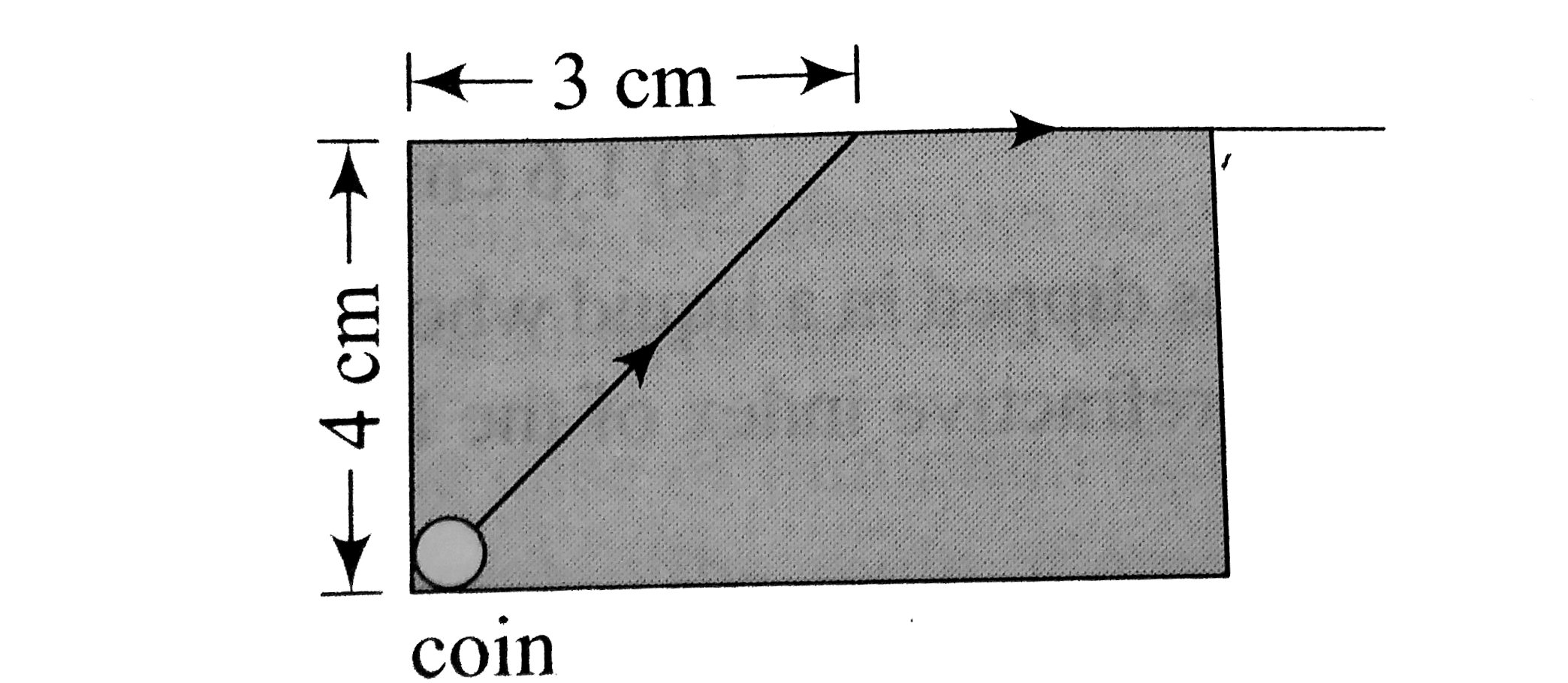
View SolutionLight enters at an angle of incidence in a transparent rod of refractive index n. For what value of the refractive index of the material of the rod the light once entered into it will not leave it through its lateral face whatsoever be the value of angle of incidence.
View Solution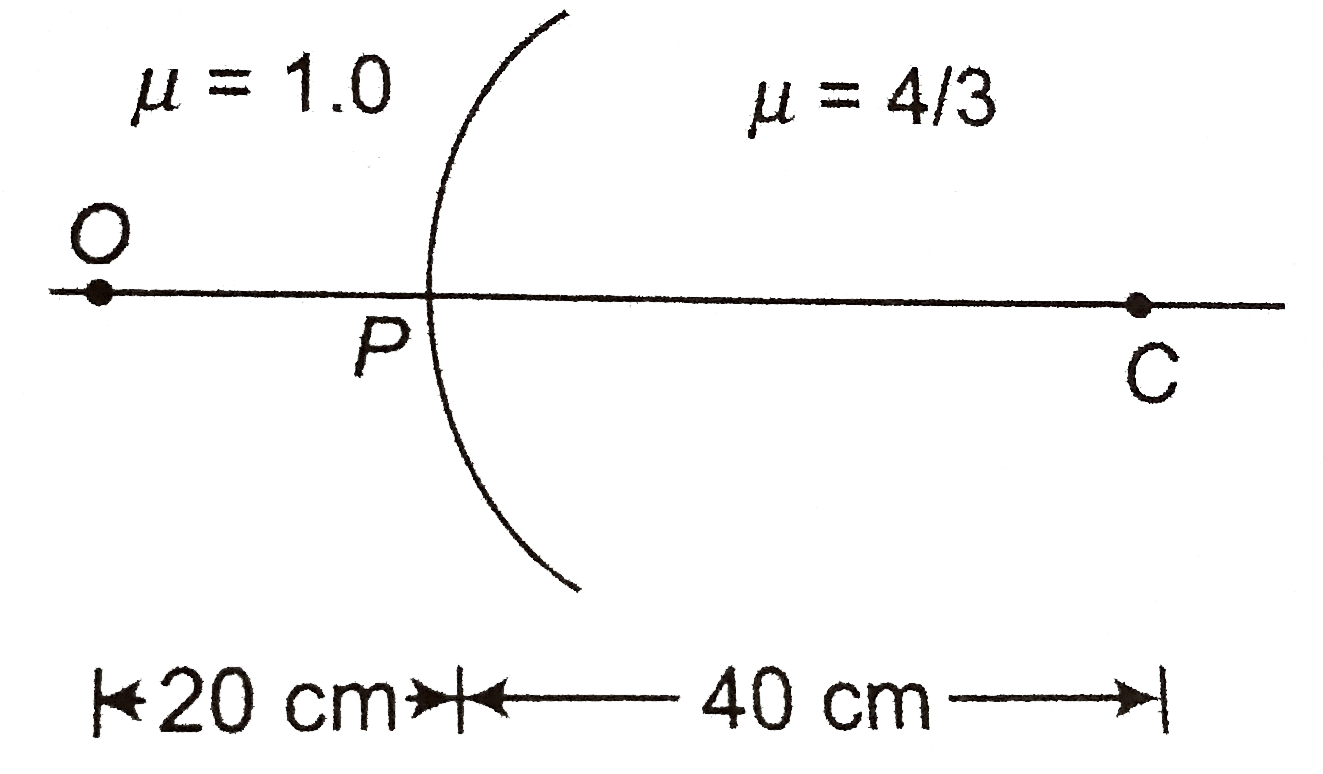
Locate the image of the point object `O`. The point `C` is centre of curvature of the spherical surface.
View SolutionA glass sphere of radius `R=10cm` is kept inside water. A ponit object O is placed at `20cm` from A as shown in figure. Find the position and nature of the image when seen from other side of the sphere. Also draw the ray diagram. Given, `mu_g=3//2` and `mu_w=4//3`
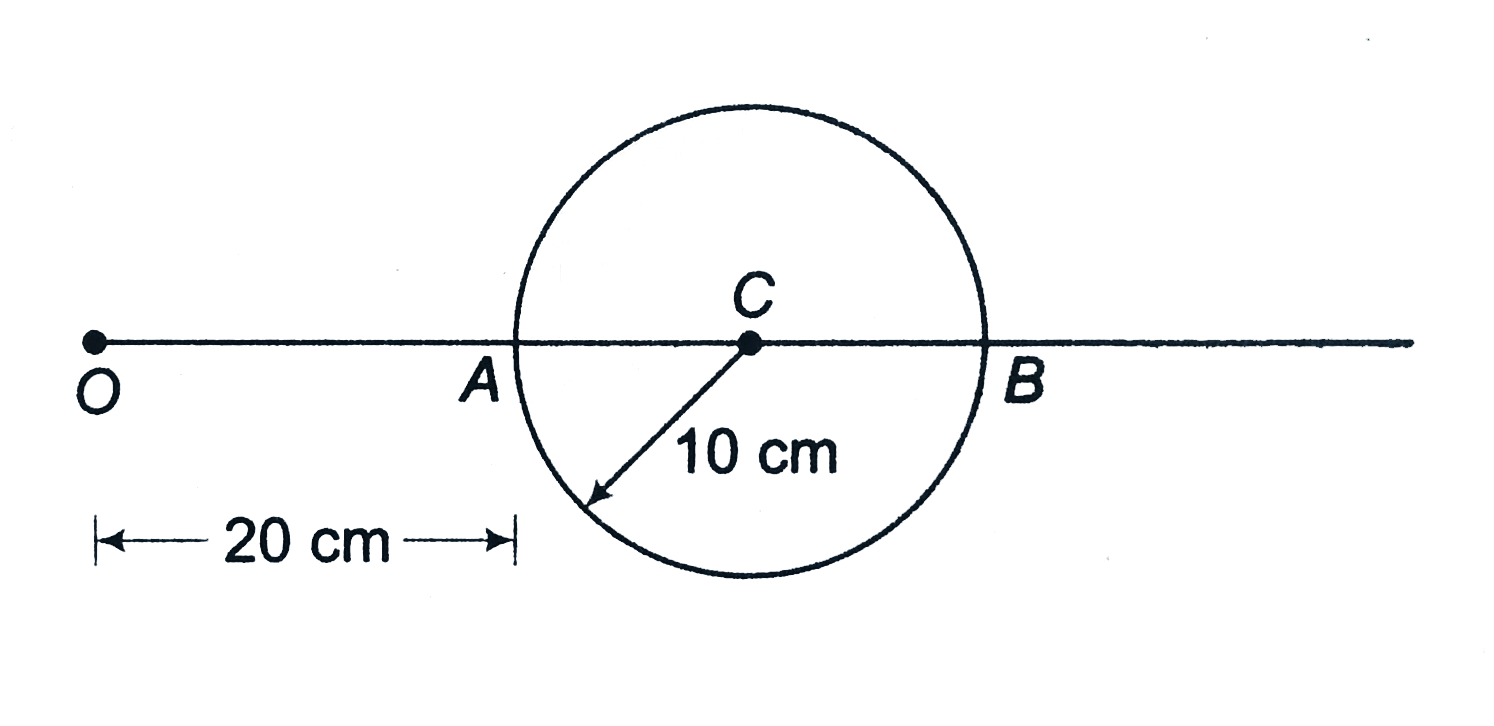
View SolutionA linear object of length 4 cm is placed at from the plane surface of hemispherical glass of radius 10 cm. The hemispherical glass is surrounded by water. Find the final position and size of the image.

View Solution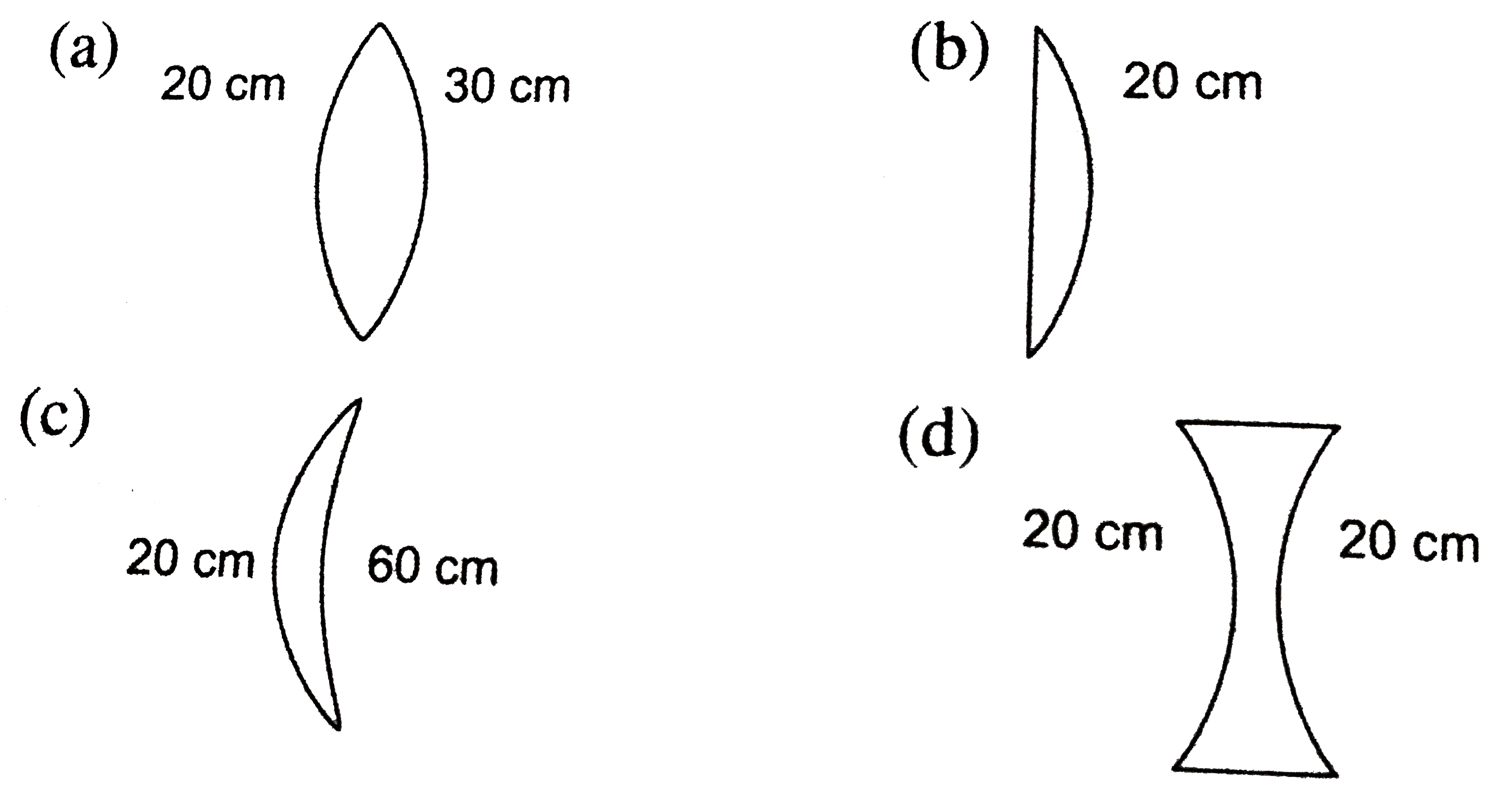
Find focal lengths of lenses made of glass `(mu=3//2)` and placed in air.
View SolutionA double convex lens is made of glass of refractive index `1.55` with both faces of same radius of curvature. Find the radius of curvature required, if focal length is `20 cm`.
View SolutionFind the refractive index of the material of a plano-convex lens, if the radius of curvature of the convex surface is 20 cm and focal length of the lens is 60 cm?
View SolutionA beam of light converges to a point `P`. A lens is placed in the path of the covergent beam `12 cm` from `P`. At what point does the beam converge if the lens is
(a) a convex lens of focal length `20 cm`
(b) a concave lens of focal length `16 cm` ?
View SolutionFocal length of a convex lense in air is `10cm`. Find its focal
length in water. Given that `mu_g=3//2` and `mu_w=4//3`.
View SolutionIf the focal length of the lens is 20 cm, find the distance of the image from the lens in the following figure?

View SolutionThe distance between two point sources of light is `24cm.` Find out where would you place a converging lens of focal length `9cm,` so that the images of both the sources are formed at the same point.
View SolutionAn object of size `3.0 cm` is placed `14 cm` in front of a concave lens of focal length `21 cm`. Describe the image produced by the lens. What happens if the object is moved further from the lens ?
View SolutionFind the distance of an object from a convex lens if image is
two times magnified. Focal length of the lens is `10cm`
View SolutionAn object is placed at a distance of 80 cm from a screen. Where should a convex lens of focal length of 15 cm will be placed so as to obtain a real image of an object?
View SolutionThe image of a small electric bulb fixed on the wall of a room is to be obtained on the opposite wall `3 m` away by means of a large convex lens. What is the maximum possible focal length of the lens required for the purpose ?
View SolutionFor a given lens, the magnification was found twice as large when as when the object was 0.15 m distance from it as when the distance was 0.2 m. Find power of the lens.
View SolutionA spherical convex surface separates object and image space of refractive index `1.0 and 4/3.` If radius of curvature of the surface is `10cm,` find its power.
View SolutionA thin glass (refractive index 1.5) lens has optical power of `-5D` in air. Its optical power in a liquid medium with refractive index 1.6 will be
View SolutionTwo thin converging lenses are placed on a common axis, so that the centre of one of them coincides with the focus of the other. An object is placed at a distance twice the focal length from the left hand lens. Where will its image be? What is the lateral magnification? The focal of each lens is f.
View SolutionTwo thin converging lenses are placed on a common axis, so that the centre of one of them coincides with the focus of the other. An object is placed at a distance twice the focal length from the left hand lens. Where will its image be? What is the lateral magnification? The focal of each lens is f.
View SolutionTwo equi-convex lenses of focal length `30cm` and `70cm,` made of material of refractive index`=1.5,` are held in contact coaxially by a rubber band round their edges.A liquidof refractive index `1.3` is introduced in the space between the lenses filling it completely. Find the position of the image of a luminous point object placed on teh axis of the combination lens at a distance of `90cm` from it.
View SolutionTwo thin equiconvex lenses each of focal length 0.2 m are placed coaxially with their optic centres 0.5m apart. Then find the focal length of the combination.
View SolutionTwo convex lenses, each of focal length 15 cm, are placed at a separation of 20 cm with their principal coinciding.
(i) Show that a light beam coming parallel to the principal axis diverges as it comes out of the lens system.
(ii) Find the location of the virtual image formed by the lens system of an object placed far away.
(iii) Find the focal length of equivalent lens.
View SolutionTwo plano-concave lenses of glass of refractive 1.5 have radii of curvature of 20 and 30 cm. They are placed in contact with curved surface towards each other and the space between yhem is filled with a liquid of refractive index 2/3. Find the focal length of the system.
View SolutionA converging lens of focal length 20 cm and a converging mirror of focal length 10 cm are placed 60 cm apart with common principal axis. A point source is placed in between the lens and the mirror at a distance of 50 cm from the lens. Find the locations of the images formed.
View SolutionA converging lens and a diverging mirror are placed at a separation of 20 cm. The focal length of the lens is 30 cm and that of the mirror is 50 cm. Where should a point source be placed between the lens and the miror, so that the light, after getting reflected by the mirror and then getting transmitted by the lens, comes out parallel to the principal axis?
View SolutionA biconvex thin lens is prepared from glass `(mu=1.5)`, the two bounding surfaces having equal radii of 25 cm each. One of the surfaces is silvered from outside to make it reflecting. Whee should an object be placed before this lens so that the image is formed on the object itself?
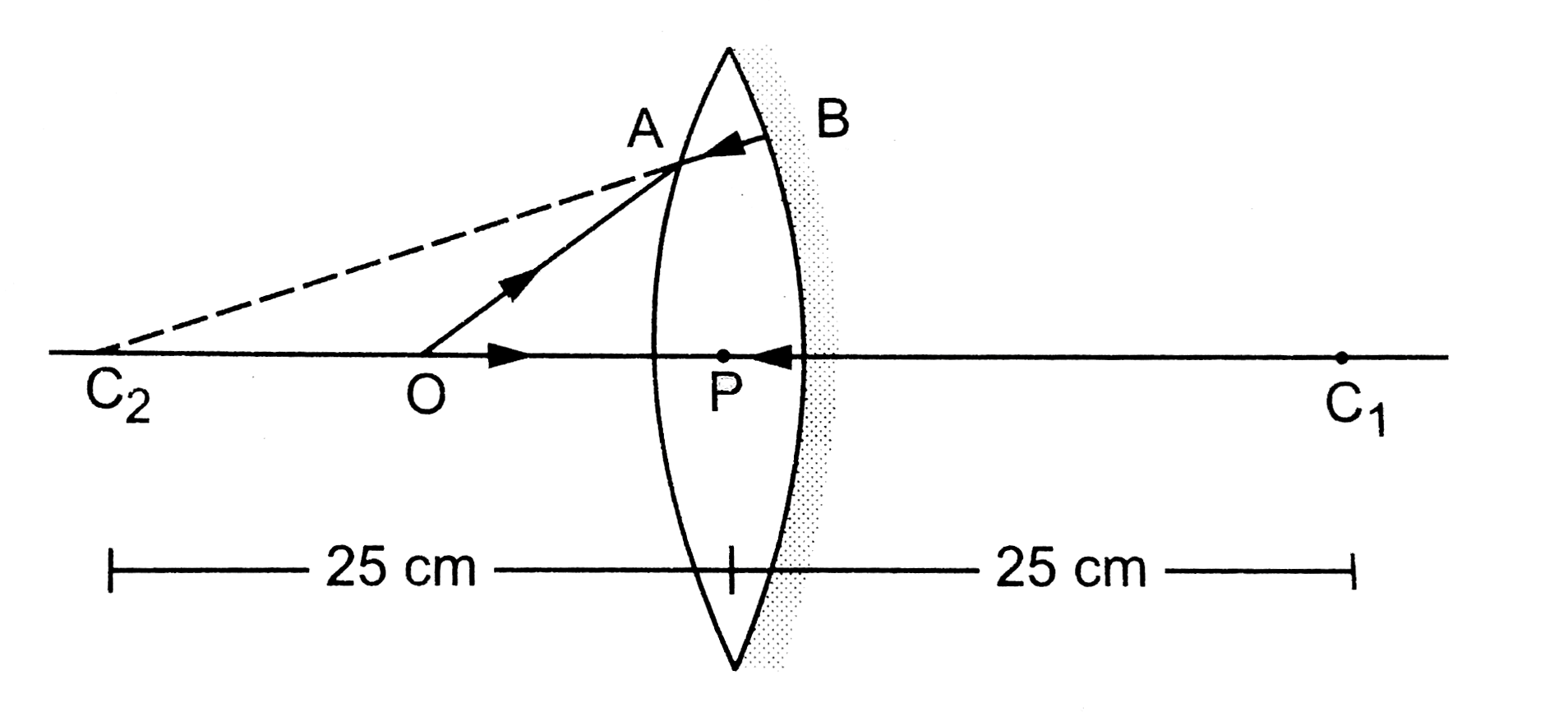
View SolutionA concave mirror of radius 40 cm lies on a horizontla tale and wateis filled in it up t a heightof 5.00 cm. A small dust particle floats on the water surface at a point P vertically above tge pointof contact of the miror with the table. Locate the image of the dust particle as seen from a point directly above it. tEh refractie index of water is 1.33.
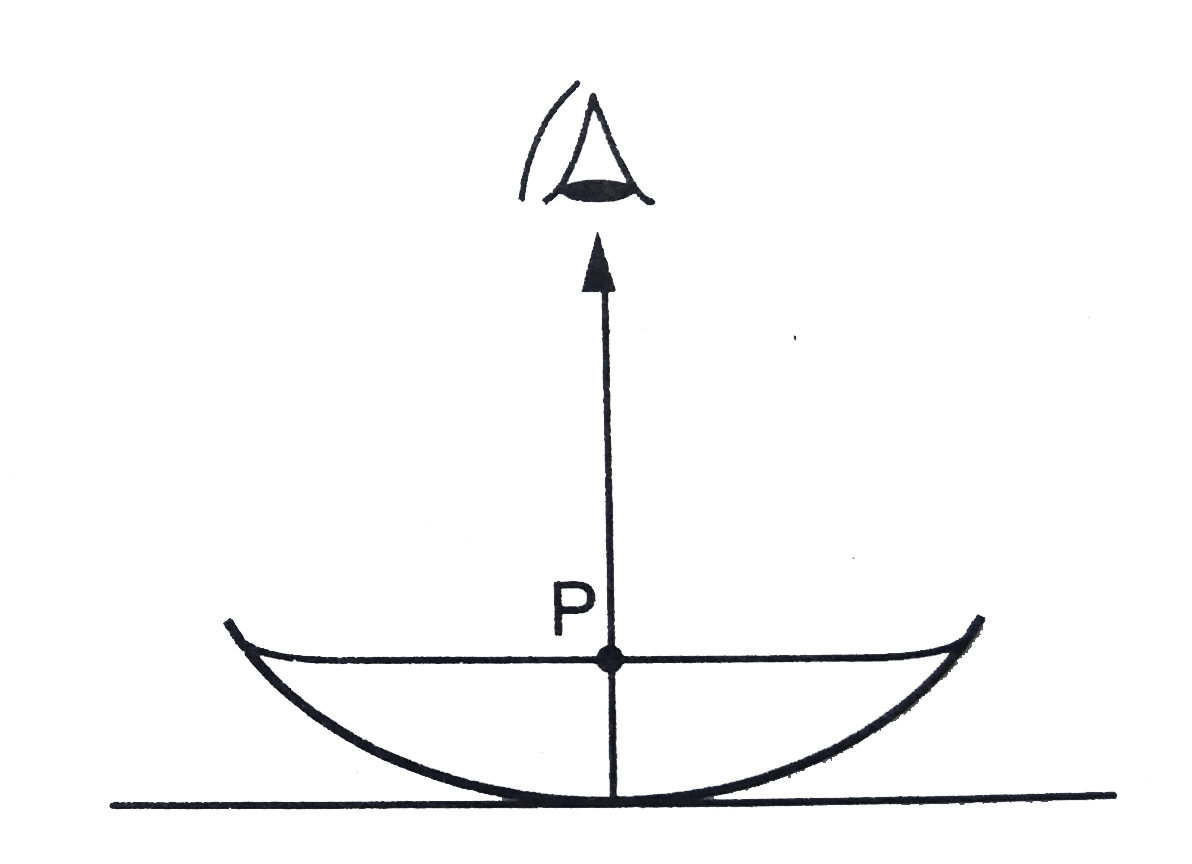
View SolutionA ray of light is incident at an angle of `60^@` on the face of a prism having refracting angle `30^@.` The ray emerging out of the prism makes an angle `30^@` with the incident ray. Show that the emergent ray is perpendicular to the face through which it emerges and calculate the refractive index of the material of prism.
View SolutionThe refracting angle of a glass prism is `30^@.` A ray is incident onto one of the faces perpendicular to it. Find the angle `delta` between the incident ray and the ray that leaves the prism. The refractive index of glass is `mu=1.5.`
View SolutionThe angle of minimum deviation for a glass prism with `mu=sqrt3` equals the refracting angle of the prism. What is the angle of the prism?
View SolutionOne face of a prism with a refrective angle of `30^@` is coated with silver. A ray of light incident on another face at an angle of `45^@` is refracted and reflected from the silver coated face and retraces its path. What is the refractive index of the prism?
View SolutionA prism is made of glass of unknown refractive index. A parallel beam of light is incident on a face of the prism. By rotating the prism, the minimum angle of deviation is measured to be `40^@`. What is the refractive index of the prism ? If the prism is placed in water `(mu = 1.33)`, predict the new angle of minimum deviation of the parallel beam. The refracting angle of prism is `60^@`.
View SolutionThe refracting angle of a prism is A and refractive index of the material of prism is `cot(A//2)` . The angle of minimum deviation will be
View SolutionAt what angle should a ray of light be incident on the face of a prism of refracting angle `60^(@)` so that it just suffers total internal reflection at the other face ? The refractive index of the prism is 1.524.
View SolutionAn isosceles glass prism has one of its faces silvered. A light ray is incident normally on the other face which is identical in size to the silvered face. The light ray is reflected twice on the same sized faces and emerges through the base of the prism perpendicularly. Find the minimum value of refractive index of the material of the prism.
View SolutionThe refractive indices of flint glass for red and violet light are 1.613 and 1.632, respectively. Find the angular dispersion produced by the thin prism of flint glass having refracting angle `4^(@)`.
View SolutionFind the dispersive power of flint glass. The refractive indices of flint glass for red, yellow and violet light are 1.613, 1.620 and 1.632 respectively.
View SolutionWhite light is passed through a prism of angle `4^(@)`. If the refractive indices for red and blue colours are 1.641 are 1.659 respectively, then calculate the angle of deviation between them, also calculate the dispersive power.
View SolutionWe have to combine a crown glass prism of angle `4^(@)` with a flint glass prism in such a way that the mean ray passes undeviated, find (i) the angle of the flint glass prism needed and (i) the angular dispersion produced by the combination when white light goes through it. Refractive indices for red, yellow and violet light are 1.514, 1.517 and 1.523 respectively for crown glass and 1.613, 1.620 and 1.632 for flint glass.
View SolutionIt is given that the aispersive powers of crown and flint glasses are 0.06 and 0.10 respectively. Also the refractive indices for yellow light for these glasses are 1.517 and 1.621, respectively. We have to form an achromatic combination of prism of crown and flint glasses which can produce a deviation of `1^(@)` in the yellow ray. Evaluate the refracting angles of the two prisms needed.
View SolutionA 20 D lens is used as a magnifier. Where should the object be placed to obtain maximum angular magnification? (Given, D=25 cm).
View SolutionAn object is seen through a simple microscope of focal length 20 cm. Find the angular magnification produced, if the image is formed at 30 cm from the lens.
View SolutionThe separation between the objective and the eyepiece of a compound microscope can be adjusted between 9.8 cm to 11.8 cm. If the focal lengths of the objective and the eyepiece are 1.0 cm and 6 cm respectively, find the range of the magnifying power if the image is always needed at 24 cm from the eye.
View SolutionA compound microscope has a magnifying power of 100 when the image is formed at infinity. The objective has a focal length of 0.5 cm and the tube length is 6.5 cm. Find the fbcal length of the eyepiece.
View SolutionA small telescope has an objective lens of focal length `140 cm` and eye piece of focal length `5.0 cm`. What is the magnifying power of telescope for viewing distant objects when
(a) the telescope is in normal adjustment (i.e. when the image is at infinity)
(b) the final image is formed at the least distance of distinct vision `(25 cm)`.
View SolutionA small telescope has an objective lens of focal length `144 cm` and an eye-piece of focal length `6.0 cm`. What is the magnifying power of the telescope ? What is the separation between the objective and the eye-piece ?
View SolutionThe eye-piece of an astronomical telescope has focal length of 10 cm. The telescope is focused for normal vision of distant objects when the tube length is 1.0 m. Find the focal length of the objective and the magnifying power of the telescope.
View SolutionAn astronomical telescope has an angular magnification of magnitude `5` for distant object. The separation between the objective and eyepiece is `36cm` and the final image is formed at infinity. Determine the focal length of objective and eyepiece.
View SolutionAn astronimical telescope is to be designed to hve a magnifying power of 50 in normal adjustment. If the length of the tube is 102 cm, fid the powers of the objective and the eyepiece.
View SolutionA telescope has an objective of focal length 50 cm and an eye-piece of focal length 5 cm. The least distance of distinct vision is 25 cm. The telescope is focused for distinct vision on a scale 2 m away from the objective. Calculate (i) magnification produced and (ii) separation between objective and eyepiece.
View SolutionA Galilean telescope is 27 cm long when focussed to form an image at infinity. If the objective has a focal length of 30 cm, what is the focal length of the eyepiece?
View SolutionCalculate the resolving power of a microscope with cone angle of light falling on the objective equal to `60^(@)`. Take `lambda = 600 nm , mu` for air `= 1`.
View SolutionAssume that light of wavelength `6000 Å` is coming from a star. What is the limit of resolution of a telescope whose objective has a diameter of 100 inch ?
View SolutionThe diameter of the pupil of human eye is about `2 mm`. Human eye is most sensitive to the wavelength `555 nm`. Find the limit of resolution of human eye.
View SolutionA person who can see things most clearly at a distance of `10 cm`. Requires spectacles to enable to him to see clearly things at a distance of `30 cm.` What should be the focal length of the spectacles ?
View SolutionThe power of a lens used by short sighted person, is -2D. Find the maximum distance of an object which he can see without spectacles.
View SolutionIf a person can sees clearly at a distance of 100 cm, then find the power of leris used to see object at 40 cm.
View SolutionA myopia person has been using spectacles of power `- 1.0` dioptre for distant vision. During old age, he also needs to use separate reading glasses of power `+ 2.0` dioptre. Explain what may have happened.
View Solution
Examples questions and complete solutions for chapter RAY OPTICS of DC PANDEY PHYSICS (HINGLISH) of Class 12